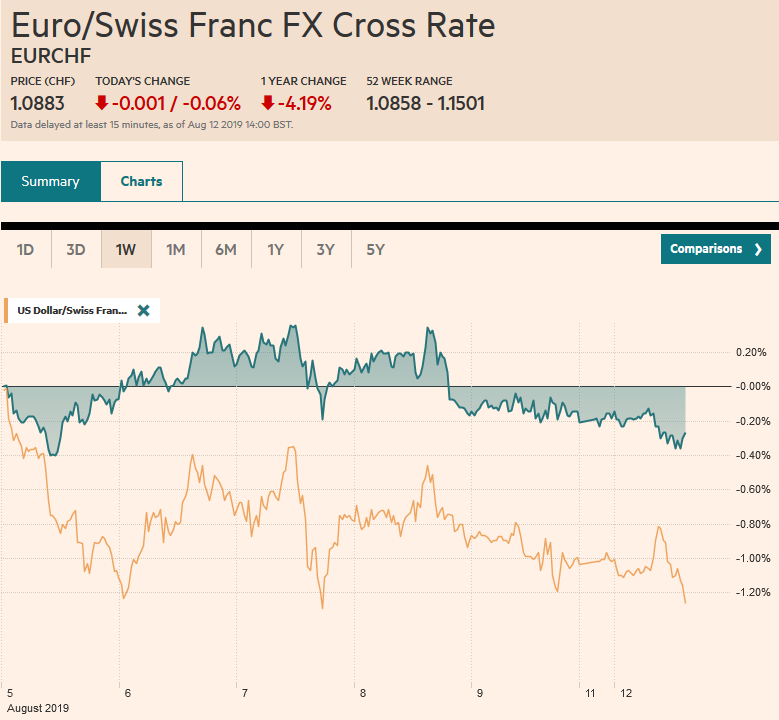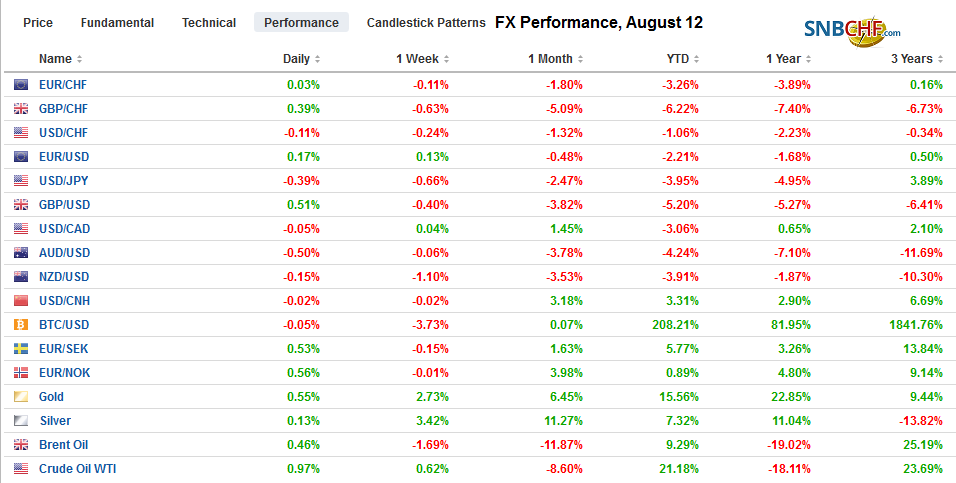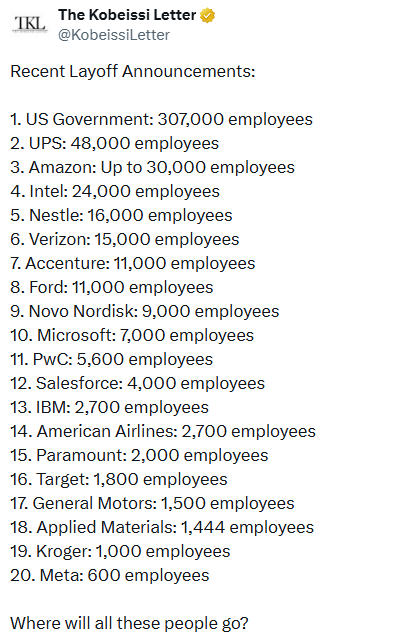Swiss FrancThe Euro has fallen by 0.06% to 1.0883 |
EUR/CHF and USD/CHF, August 12(see more posts on EUR/CHF, USD/CHF, ) Source: markets.ft.com - Click to enlarge |
FX RatesOverview: China again tried to temper the downside pressure on the yuan, and this appears to be helping the risk-taking attitude. Many centers in Asia were closed today, including Japan and India, though most of the other equity markets advanced modestly, including China, Korea, and Australia. Europe’s Dow Jones Stoxx 600 opened firmer but is staddling little changed levels unable to stain any upside momentum. Italian equities, including bank shares, are struggling to stabilize after the pre-weekend drubbing amid political anxiety. There is an attempt by the Five Star Movement and the center-left PD to reach an agreement that previously proved elusive to avoid an election. US bonds firmer as the 10-year yield slips back toward 1.70%. US equities have softened in the European morning. Last week’s gap in the S&P 500 (~2892.2-2894.5) is important for the near-term outlook. The dollar is trading higher against most of the major and emerging market currencies. News that the Fernandez beat Macri handily in Argentina (~47%-32%) will scare investors. Fernandez and his running mate Cristina Kirchner are seen as likely reversing the pro-market reforms of Macri. Gold is recovering after slipping to three-day lows, and oil is lower after rallying 6.5% over the past two sessions. |
FX Performance, August 12 |
Asia Pacific
The PBOC set the dollar’s reference rate at CNY7.0211, while models suggested it should be at CNY7.0290. This demonstrates that Chinese officials are moderating the downward pressure on the yuan, even though the pre-weekend fix was lower at CNY7.0136. The yuan may weaken a little bit more tomorrow before stabilizing on Wednesday.
The situation in Hong Kong may reach a climax soon. Local officials have become more aggressive toward the demonstration, and more force is reportedly being used. China’s patience is also running thin. The rhetoric is escalating as well, with references to the protesters as “terrorists.” With the economic disruption continuing, all flights reportedly have been canceled today. The Hong Kong dollar is edging lower, and the dollar is approaching the HKD7.85 cap.
South Korea’s first 10 days of August trade figures give little reason for optimism, and confirmation that it will drop Japan from its preferred trading partner list in a tit-for-tat move shows tensions continue to run high. In the first 10 days of the month, South Korea exports fell 22.1% year-over-year. Exports to China were off 28.3% and to Japan down by 32.3%. Semiconductor exports fell by 34.2%, while mobile telephone exports surged 41.6%. Imports from Japan fell 18.8%, while Canada appears to have picked up the slack and jumped almost 118%.
The dollar is being drawn toward JPY105, which is a significant technical level. The market may be reluctant to violate it with Japanese participation, and there is a $1.5 bln option stuck there that expire today and another that expires tomorrow. The JPY105.50 area may cap upticks and reinforced today maybe by the expiration of a $1.5 bln option at JPY105.50. The Australian dollar is extended its pre-weekend pullback. Its losses were recorded mostly in scored in the European morning. It is approaching initial support in the $0.6730-$0.6750 area and the intraday. The risks of a crackdown in Hong Kong is rising and would elicit a market reaction if it materializes. It would likely weigh on Chinese and Hong Kong shares, even if it buoys the Hong Kong dollar. Demand for gold (and maybe cyber currencies too).
Europe
Italian politics remains front and center. Fitch kept the sovereign rating at BBB with a negative outlook ahead before the weekend was not surprising and is of little comfort today. A decision is expected later today about the timing of the vote of confidence now that Salvini threatens that the League will leave the coalition with the Five Star Movement. The alliance was never smooth or natural. There seems to be an attempt by the center-left PD and M5S to try again to form a government, though the current configuration was a result of the earlier failure to do so. What has changed is that the League, the junior member of the coalition, has outflanked M5S and recent polls put is support near 40%, which if secured in an election, would give it bonus seats and a possible outright majority. Meanwhile, the latest news from the central bank indicated some positive developments. The amount of bad loans fell in June (to 89.8 bln euros from 92.0 bln in May), private deposits in the banking system rose (3.4% year-over-year), and banks pared their government bonds holdings (to 390 bln euros in June from 392 bln in May). The timing of the vote of confidence may also be indicative of the relative strength of the conflicting forces. Salvini is pushing for the vote soon, while the August 15 national holiday gives M5S and others a reason to delay until next week. Italian bonds are holding on to small gains, while the equity market and bank shares saw initial gains sold.
Swiss sight deposits jumped CHF2.8 bln, the most in two years last week. This is seen as evidence that the Swiss National Bank quietly intervened last week to smooth the franc’s appreciation to new two-year highs against the euro. The Swiss franc is trading firmer today, and the euro is approaching last week’s low near CNF1.0860. Swiss officials do not seem particularly concerned that the intervention could bring them back into the crosshairs of the US foreign exchange policy, where countries that have large current account surpluses are called out for repeated intervention. The Swiss had recently been dropped off the US watch list. While some chart support is seen near CHF1.08, the risk extends toward CHF1.05.
The euro has been sold to a five-day low near $1.1160. Recall that the euro had been marked up at the beginning of last week and then was largely rangebound for the remainder of the week. The upside momentum stalled in at $1.1250. The prospects of Italian political tensions while the ECB contemplates another easing phase, and the region’s locomotive Germany stalls (June exports show the biggest drop last week in three years, and industrial output fell by nearly 2% in Q2, its biggest quarterly fall in seven years) does nothing to make the currency more attractive. Sterling slipped closer to $1.20 today before recovering, helped by gains against the euro. It may be capped in the $1.2080-$1.2100 area.
America
Argentine news will weigh on sentiment, and the Mexican peso appears to have been sold in sympathy. Investors are surprised by the magnitude of Macri’s defeat and is concerned about the policies of a Fernandez-Kirchner government. Investors reportedly were already paring exposures ahead of the poll, and this will likely see it accelerate. In contrast, at the end of last week, Brazil’s lower house passed pension reforms that included an increase in the minimum retirement age, reduced benefits, and lower cost social security. The bill now goes to the Senate. Pension reform has long been elusive and is seen as the key to addressing Brazil’s fiscal policy.
The North American economic calendar is light today but picks up with the US CPI tomorrow and Mexico’s rate decision on Thursday. The US reports its monthly budget deficit for July amid a yawning shortfall. The monthly deficit is expected to be around $120 bln compared with almost $77 bln in July 2018. The monthly US crop report is also due this afternoon. Elsewhere, the EIA’s drilling report is due, and OPEC monthly outlook will be released at the end of the week. Last week, the EIA reported that US oil stocks increased in the week ending August 2 for the first time in eight weeks. Before the weekend, Baker-Hughes said the US rig count fell by 8. The number of rigs in operation has not risen since the end of May.
The US dollar is finding support near CAD1.3200, though the band of support extends toward CAD1.3180. There is an option for $1.5 bln at CAD1.3250 that will be cut today. The high seen in the European morning is just below there, and the intraday technicals suggest it may be safe. The dollar is spiking higher against the Mexican peso, which partly serves as a proxy for less liquid/accessible emerging market currencies. The dollar held the 200-day moving average (~MXN19.36) ahead of the weekend and is approaching last week’s highs near MXN19.74. The next target is the June high close to MXN19.88, and there is more talk of a test on MXN20.00, which has not been seen since last December. The US dollar finished last week near ARS45.31. It began the month close to ARS43.88. The high was set in April around ARS.46.53. There appears to be scope for ARS49.00-ARS50.00.
Full story here Are you the author? Previous post See more for Next post
Tags: #USD,$CNY,Argentina,Currency Movements,EUR/CHF,FX Daily,Italy,newsletter,OIL,USD/CHF
































